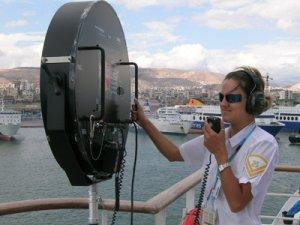Non-lethal systemsProtests spur sonic blaster sales boom
With the spate of protests from the Occupy Wall Street movement sweeping across the country, there has been a surge of interest in non-lethal crowd control systems; in particular U.S. police and first responders have taken a keen interest in Long-Range Acoustic Devices (LRAD)

Sonic blaster is becoming a preferred non-lethal crowd control method // Source: offiziere.ch
With the spate of protests from the Occupy Wall Street movement sweeping across the country, there has been a surge of interest in non-lethal crowd control systems.
In particular U.S. police and first responders have taken a keen interest in Long-Range Acoustic Devices (LRAD). The company which manufacturers the device, LRAD Corp., has seen sales rocket to a record $26 million in fiscal year 2011, an increase of 57 percent compared to the previous year.
Originally created as a long range communication device for the U.S. Navy to order away small boats approaching warships, police in the United States have increasingly used them as “sound cannons,” as critics call them.
At the 2009 G-20 summit in Pittsburgh, police deployed LRADs to disperse protestors and now the American Civil Liberties Union (ACLU) has filed a lawsuit against the city alleging that one woman’s hearing has been permanently damaged as a result.
According to LRAD Corp., the device is merely an acoustic amplifier like a megaphone, only louder, and is a more benign solution to dispersing crowds than rubber bullets and tear gas.
Robert Putnam, a spokesman for the company, said LRAD is not a weapon but a long-range communication system to clearly broadcast information, instructions, and warnings.
LRADs come in a variety of shapes and sizes ranging from their lightest fifteen-pound, batter operated unit to their 320-pound device that has a range of nearly two miles.
The smallest unit is capable of emitting 137 decibels at one meter. In comparison, a military jet taking off with afterburners at fifty feet is 130 decibels.
According to the U.S. Occupational Safety and Health Administration, the pain threshold is 140 decibels and Putnam said LRAD broadcast levels are deliberately kept just below the threshold to avoid causing permanent hearing damage. But Putnam did acknowledge that prolong exposure could cause damage.
In the ACLU’s lawsuit, Karen Piper, an English professor at the University of Missouri, was visiting Pittsburg on a research trip to study whether the protestors had any effect on the International Monetary Fund and World Bank. While surveying the protests, Piper said she was standing roughly 100 feet from an LRAD mounted on a moving vehicle when she heard a “piercing, continuous, high-pitched sound” for several minutes, resulting in permanent hearing loss.
On Piper’s behalf, the ACLU has sued the city over violations of Piper’s constitutional rights of assembly, privacy, and due process. In addition the lawsuit claims that the city was reckless in its uses of the LRAD, forcing Piper to “endure great pain, suffering, and inconvenience.”
Pittsburg denied Piper’s claims arguing that it had used LRAD in accordance with the manufacturer’s safety instructions.
Putnam said that at 100 feet away, the loudest sounds Piper would have heard would have been at 120 decibels and on a moving LRAD her exposure would have been limited to seconds, not minutes.
The National Institute for Occupational Safety and Health cautions that exposure to 120 decibels should not equal or exceed nine seconds.
Regardless of the controversy, Raymond DeMichiei, the deputy director of the Pittsburgh Office of Emergency Management and Homeland Security, which supplied the devices to Pittsburgh police for the G-20 summit, believes that LRADs are still a safe and humane way to control crowds.
“What would you rather have us do, the old 1964 routine with fire hoses and billy clubs?” DeMichiei asked. “I think it’s a lot more humane to make people uncomfortable because their ears hurt, and they leave.”
